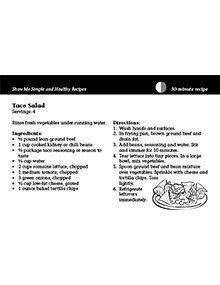

Show Me Simple and Healthy Recipes — Taco Salad (Bundle of 25)
Revised $10
Editor's note
The following abstract describes a publication that is available as a downloadable PDF. It is also available printed as part of the NC1 Show Me Simple and Healthy Recipes set
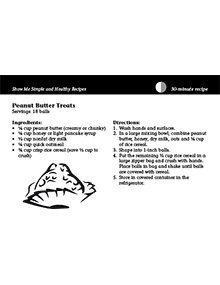
Show Me Simple and Healthy Recipes — Peanut Butter Treats (Bundle of 25)
Revised $10
Editor's note
The following abstract describes a publication that is available as a downloadable PDF. It is also available printed as part of the NC1 Show Me Simple and Healthy Recipes set

Show Me Simple and Healthy Recipes — Colorful Veggie Pockets (Bundle of 25)
Revised $10
Editor's note
The following abstract describes a publication that is available as a downloadable PDF. It is also available printed as part of the NC1 Show Me Simple and Healthy Recipes set
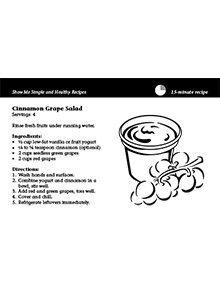
Show Me Simple and Healthy Recipes — Cinnamon Grape Salad (Bundle of 25)
Revised $10
Editor's note
The following abstract describes a publication that is available as a downloadable PDF. It is also available printed as part of the NC1 Show Me Simple and Healthy Recipes set
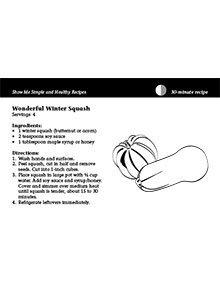
Show Me Simple and Healthy Recipes — Wonderful Winter Squash (Bundle of 25)
Revised $10
Editor's note
The following abstract describes a publication that is available as a downloadable PDF. It is also available printed as part of the NC1 Show Me Simple and Healthy Recipes set
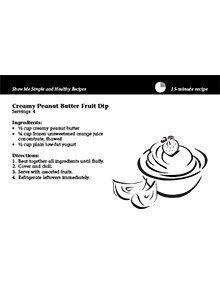
Show Me Simple and Healthy Recipes — Creamy Peanut Butter Fruit Dip (Bundle of 25)
Revised $10
Editor's note
The following abstract describes a publication that is available as a downloadable PDF. It is also available printed as part of the NC1 Show Me Simple and Healthy Recipes set
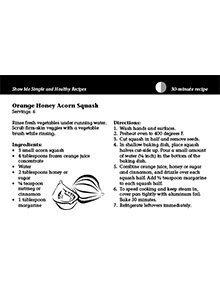
Show Me Simple and Healthy Recipes — Orange Honey Acorn Squash (Bundle of 25)
Revised $10
Editor's note
The following abstract describes a publication that is available as a downloadable PDF. It is also available printed as part of the NC1 Show Me Simple and Healthy Recipes set
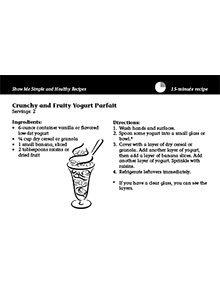
Show Me Simple and Healthy Recipes — Crunchy and Fruity Yogurt Parfait (Bundle of 25)
Revised $10
Editor's note
The following abstract describes a publication that is available as a downloadable PDF. It is also available printed as part of the NC1 Show Me Simple and Healthy Recipes set
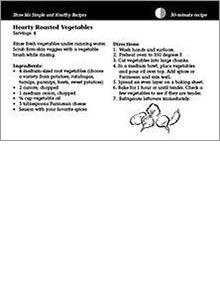
Show Me Simple and Healthy Recipes — Hearty Roasted Vegetables (Bundle of 25)
Revised $10
Editor's note
The following abstract describes a publication that is available as a downloadable PDF. It is also available printed as part of the NC1 Show Me Simple and Healthy Recipes set

Show Me Simple and Healthy Recipes — Bold Breakfast Burritos with Salsa (Bundle of 25)
Revised $10
Editor's note
The following abstract describes a publication that is available as a downloadable PDF. It is also available printed as part of the NC1 Show Me Simple and Healthy Recipes set
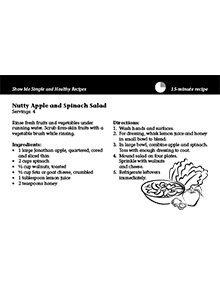
Show Me Simple and Healthy Recipes — Nutty Apple and Spinach Salad (Bundle of 25)
Revised $10
Editor's note
The following abstract describes a publication that is available as a downloadable PDF. It is also available printed as part of the NC1 Show Me Simple and Healthy Recipes set
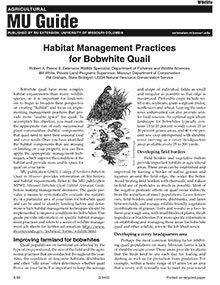
Habitat Management Practices for Bobwhite Quail
Revised
If you are a landowner considering lease hunting as a potential income-generating opportunity, learn what you need to consider beforehand. Sample leases are included in this University of Missouri Extension guide.
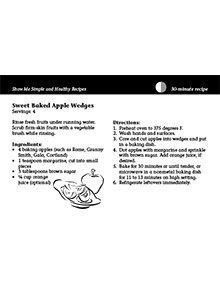
Show Me Simple and Healthy Recipes — Sweet Baked Apple Wedges (Bundle of 25)
Revised $10
Editor's note
The following abstract describes a publication that is available as a downloadable PDF. It is also available printed as part of the NC1 Show Me Simple and Healthy Recipes set

Eat Good Feel Good - Pocket Folder (Bundle of 25)
New $47
This two-pocket folder includes the MyActivity Pyramid and MyPlate graphics. It also has information and suggestions for daily calorie and food intake.

Show Me Simple and Healthy Recipes — Stove Top Lasagna (Bundle of 25)
Revised $10
Editor's note
The following abstract describes a publication that is available as a downloadable PDF. It is also available printed as part of the NC1 Show Me Simple and Healthy Recipes set
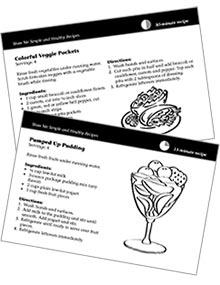
Show Me Simple and Healthy Recipes
New $10
These simple, healthy food and beverage recipes can be prepared quickly, in 15-30 minutes. Each requires just a few low-cost ingredients and includes a nutrition analysis. Get cooking today!
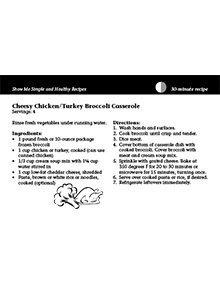
Show Me Simple and Healthy Recipes — Cheesy Chicken/Turkey Broccoli Casserole (Bundle of 25)
Revised $10
Editor's note
The following abstract describes a publication that is available as a downloadable PDF. It is also available printed as part of the NC1 Show Me Simple and Healthy Recipes set
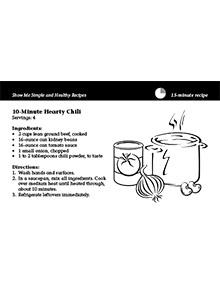
Show Me Simple and Healthy Recipes — 10-Minute Hearty Chili (Bundle of 25)
Revised $10
Editor's note
The following abstract describes a publication that is available as a downloadable PDF. It is also available printed as part of the NC1 Show Me Simple and Healthy Recipes set
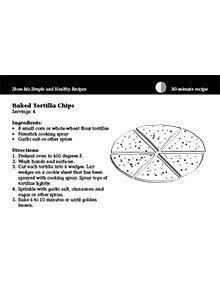
Show Me Simple and Healthy Recipes — Baked Tortilla Chips (Bundle of 25)
Revised $10
Editor's note
The following abstract describes a publication that is available as a downloadable PDF. It is also available printed as part of the NC1 Show Me Simple and Healthy Recipes set

Show Me Simple and Healthy Recipes — Personal Snack Pizzas (Bundle of 25)
Revised $10
Editor's note
The following abstract describes a publication that is available as a downloadable PDF. It is also available printed as part of the NC1 Show Me Simple and Healthy Recipes set

Show Me Simple and Healthy Recipes — Cheesy Enchilada Stack (Bundle of 25)
Revised $10
Editor's note
The following abstract describes a publication that is available as a downloadable PDF. It is also available printed as part of the NC1 Show Me Simple and Healthy Recipes set
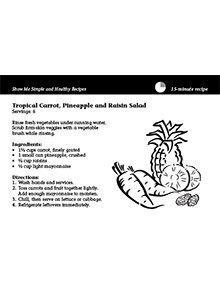
Show Me Simple and Healthy Recipes — Tropical Carrot, Pineapple and Raisin Salad (Bundle of 25)
Revised $10
Editor's note
The following abstract describes a publication that is available as a downloadable PDF. It is also available printed as part of the NC1 Show Me Simple and Healthy Recipes set
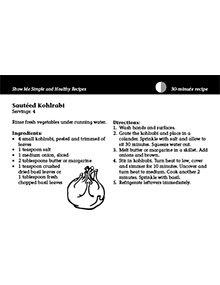
Show Me Simple and Healthy Recipes — Sauteed Kohlrabi (Bundle of 25)
Revised $10
Editor's note
The following abstract describes a publication that is available as a downloadable PDF. It is also available printed as part of the NC1 Show Me Simple and Healthy Recipes set

Cultural Food Photos card set
New $30
In this set of 60 cards, each nonbranded food card displays a Nutrition Facts label on the back, a photo of a nontraditional or cultural food.
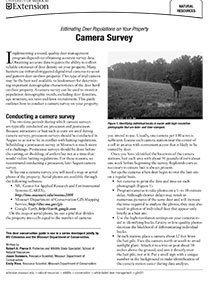
Estimating Deer Populations on Your Property: Camera Survey
Reviewed
White-tailed deer management
This deer conservation guide is one in a series developed jointly by MU Extension and the Missouri Department of Conservation.